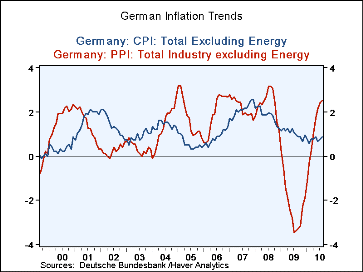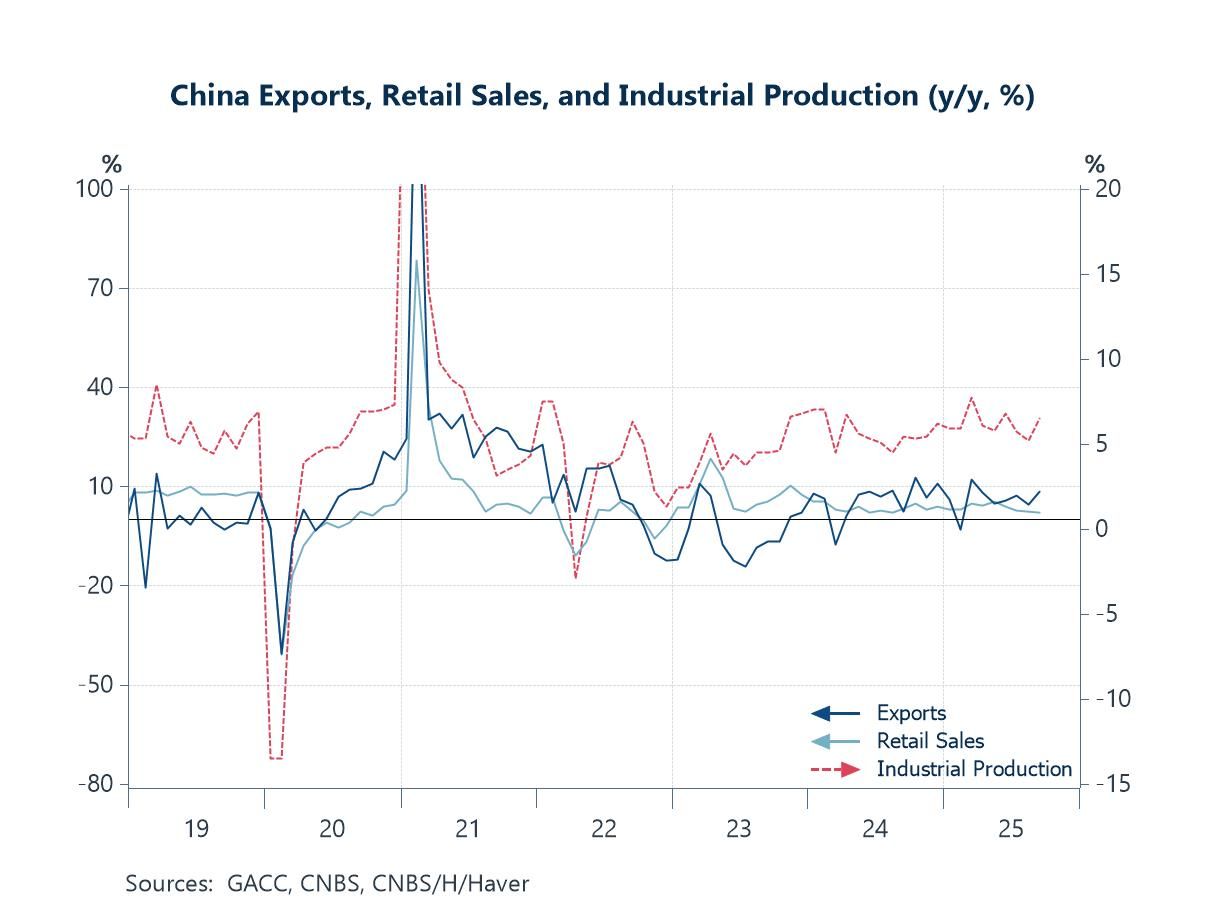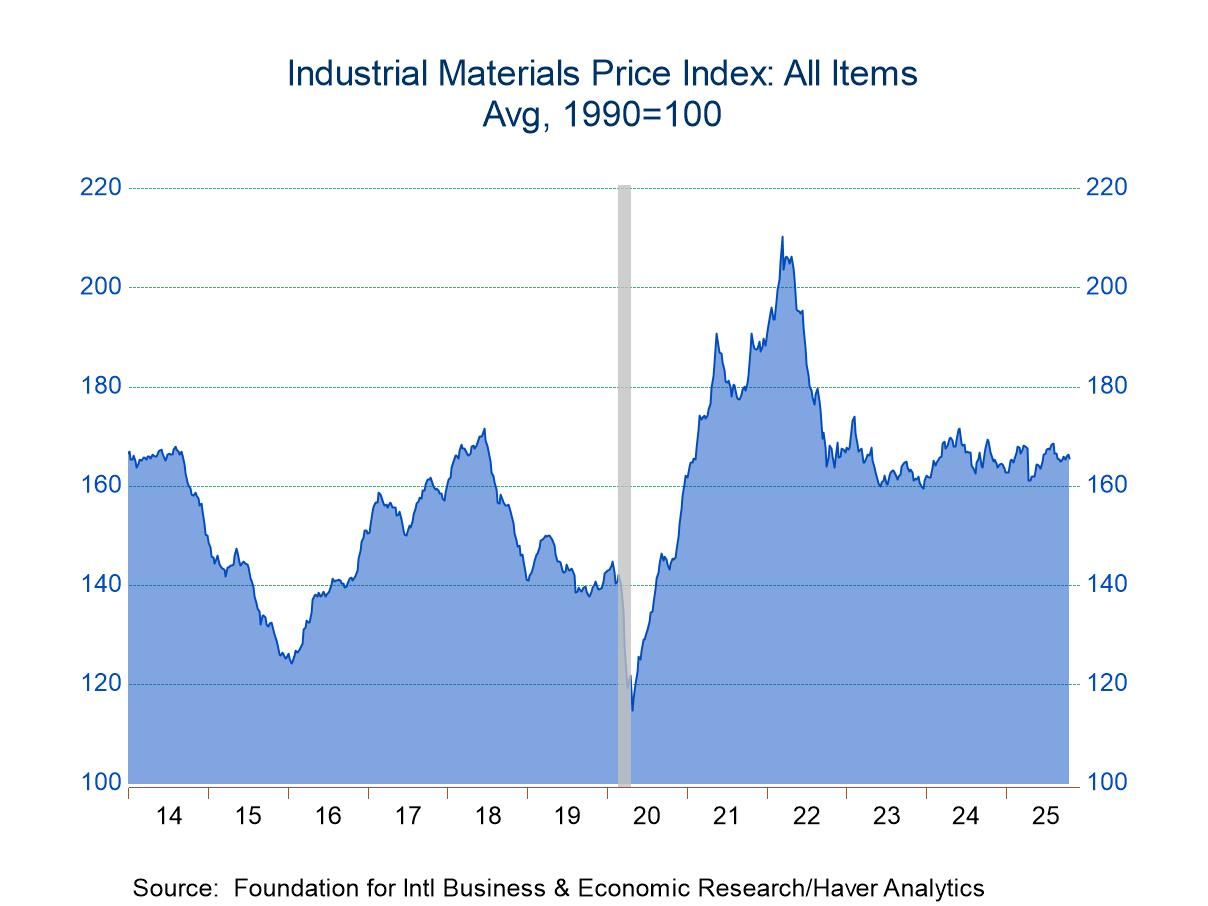 Global| Sep 17 2010
Global| Sep 17 2010German PPI Settles Down In August
Summary
The PPI facts of life: The PPI was subdued in August rising by just 0.1%. This comes after several months of elevation. The elevation, however, was not shared by the core which instead has bumped up in August after being low and [...]
 The PPI facts of life: The PPI was subdued in August rising by just 0.1%. This comes after several months of
elevation. The elevation, however, was not shared by the core which instead has bumped up in August after being low and
stable in the earlier months. The headline PPI (excluding construction) is up at a pace of 3.6% in the current quarter
with two month's worth of data in. That is about the same as its three-month pace of 3.7% which is below its six month
pace but above its Yr/Yr pace. On balance the raw pace of inflation at 'a bit over 3.5%' is undoubtedly too fast for German
authorities but this is the headline and it's the PPI, the ECB 'targets' headline consumer prices.
The PPI facts of life: The PPI was subdued in August rising by just 0.1%. This comes after several months of
elevation. The elevation, however, was not shared by the core which instead has bumped up in August after being low and
stable in the earlier months. The headline PPI (excluding construction) is up at a pace of 3.6% in the current quarter
with two month's worth of data in. That is about the same as its three-month pace of 3.7% which is below its six month
pace but above its Yr/Yr pace. On balance the raw pace of inflation at 'a bit over 3.5%' is undoubtedly too fast for German
authorities but this is the headline and it's the PPI, the ECB 'targets' headline consumer prices.
Assessing ex energy inflation trends: Ex energy the PPI rose by 0.4% but that still leaves its three month pace and Q/Q pace in Q3 at a 2.7% clip which, like the headline series, is below its six month pace but above its 12-month pace. On balance there is not much going with the PPI that suggest any troubling inflation rise. The split between the core and the headline suggests that repeated 'shocks to energy prices are playing a role here and they may not be 'shocks' as much energy moving to a higher equilibrium level. In any case there is little evidence of inflation problems in the energy PPI or of any ongoing acceleration in the headline.
| CPI And PPI ex Energy | ||
|---|---|---|
| Correlation And Variation | ||
| Correlation | StdDev | |
| PPI ex energy | 0.235 | 1.50% |
| CPI Ex energy | 0.57% | |
| Correlations Over More Than 1-Yr | ||
| Over Two Years | 0.221 | -- |
| Over Three Years | 0.120 | -- |
The PPI that cries 'Wolf!' : As we mentioned above, the ECB targets or we should say 'ceilings' the Euro-Area-wide headline CPI inflation measure. The consumer price index is much broader than the PPI since the PPI misses the huge services sector of the economy and the CPI includes it. The small table shows that for Germany the ex-energy correlation between the CPI and the PPI is not even one-quarter. That is, the PPI can't even 'explain' one –quarter of the variation in the Yr/Yr percentage change in the CPI (the R-square relationship would be even lower). Moreover, it is the PPI that is more volatile, nearly three times more volatile than the CPI. So when PPI prices are moving, they probably exaggerate whatever trend is authentically going to be passed on to the CPI. If we were to use the PPI as a bellwether for the CPI we would be getting a lot of false alarms for inflation and for
How not to use the PPI - Clearly a PPI that is 'a bit high' or 'a bit low' on standards that we would apply to the CPI is in reality probably just fine form a CPI perspective. We can see that in the chart at the top; notice how the PPI swings overshoot the CPI swings in both directions. Yet, the PPI's swings often precede real trend moves in the CPI. This complicates the potential use of the PPI. The message here is not to ignore it. Conversely the message also is this: do not believe it. So what do you do when you can't ignore it or believe it?
How to use the PPI - When the PPI embarks on a new trend the message is to be somewhat wary. Right now the clearest message from the PPI is that the big drop, or deflation signal, has been washed out by the rapid recovery of the PPI. Note that the CPI-PPI correlation does NOT get better but instead gets worse as we look at changes over two years or three years. So the cumulative PPI to CPI change over two years or more is not a useful measure here. Thus the best information in the PPI about the CPI is what it is doing NOW. Right now it is rising strongly after a period of falling sharply. The signal value of the PPI now depends much more on what it does from this point onward. Its rise is only getting into the region where it was persistently from 2006 to 2008 when it did precede a rise in ex-energy CPI inflation. A brief visit to this region is not reason enough raise any CPI-inflation fears. If the PPI were to stay at that level of inflation for an extended period of time, that might be a different matter.
| Germany PPI | ||||||||
|---|---|---|---|---|---|---|---|---|
| %m/m | %-SAAR | |||||||
| Aug 10 |
Jul 10 |
Jun 10 |
3Mo | 6Mo | 12Mo | 12Mo Y-Ago |
IN Q3 | |
| PPIxConst | 0.1% | 0.4% | 0.5% | 3.7% | 4.7% | 3.2% | -3.9% | 3.6% |
| Ex Energy | 0.4% | 0.1% | 0.2% | 2.7% | 3.7% | 2.5% | -3.3% | 2.7% |
Robert Brusca
AuthorMore in Author Profile »Robert A. Brusca is Chief Economist of Fact and Opinion Economics, a consulting firm he founded in Manhattan. He has been an economist on Wall Street for over 25 years. He has visited central banking and large institutional clients in over 30 countries in his career as an economist. Mr. Brusca was a Divisional Research Chief at the Federal Reserve Bank of NY (Chief of the International Financial markets Division), a Fed Watcher at Irving Trust and Chief Economist at Nikko Securities International. He is widely quoted and appears in various media. Mr. Brusca holds an MA and Ph.D. in economics from Michigan State University and a BA in Economics from the University of Michigan. His research pursues his strong interests in non aligned policy economics as well as international economics. FAO Economics’ research targets investors to assist them in making better investment decisions in stocks, bonds and in a variety of international assets. The company does not manage money and has no conflicts in giving economic advice.






